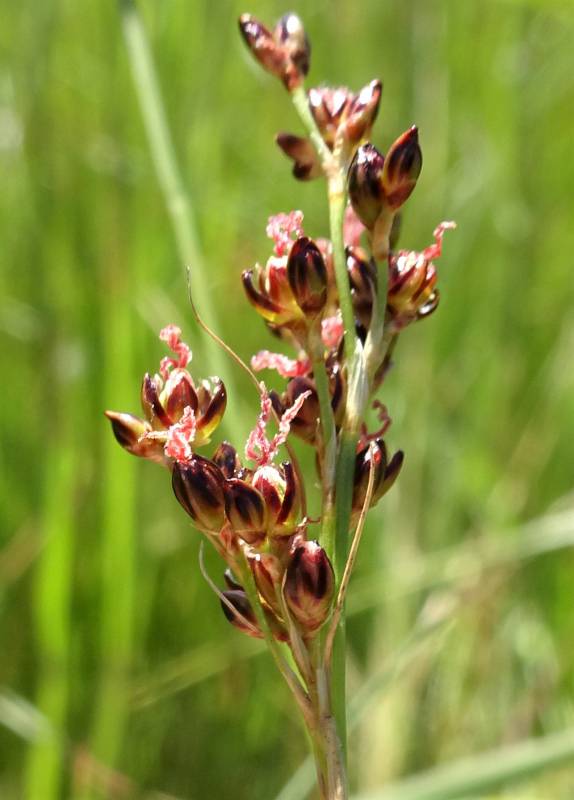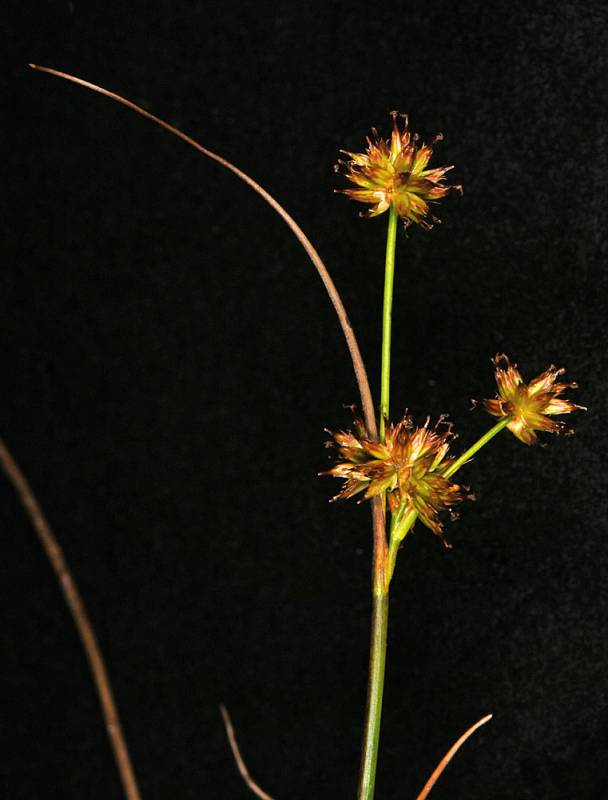|
|
knotted rish, tuberous rush
|
| Rhizomatous perennial 3-7 dm. tall. |
Perennial from slender rhizomes, the stems 1.5-4 dm. tall, arising singly from swollen nodes. |
Leaves alternate, the blades flat, 1.5-3 mm. broad; leaf bases sheathing, the sheaths several, the uppermost extending to above midlength of the flowering stem. |
Leaves alternate, 1-3, the blades semi-terete, with prominent partitions; leaf bases sheathing, the sheaths projecting into rounded auricles 1 mm. long. |
Inflorescence many-flowered, loosely cymose, 3-10 cm. long; perianth 3-4 mm. long, the 6 segments dark brown with a greenish mid-stripe, blunt, and hooded at the tip; stamens 6, the anthers much longer than the filaments. |
Inflorescence terminal, up to 5 cm. long, exceeded by the upper leaf and the involucral bract; heads 3-15, many-flowered, up to 1 cm. long; perianth about 3.5 mm. long, greenish-brown to tawny, the 6 segments narrowly lanceolate, acuminate and somewhat awl-shaped, subequal; stamens 6. |
Capsule ovoid to obovoid, rounded, about equal to the perianth. |
Capsule conic, tapered almost from the base to a long beak that much exceeds the perianth. |
|
|
|
|
| June-September |
June-August |
| Coastal salt marshes. |
Shores, wet meadows, springs, and ditches. |
Occurring west of the Cascades crest in counties along the Puget Sound and outer coast; British Columbia to Oregon, east sporadically across the U.S. to the northern Atlantic coast of the U.S. and Canada; circumboreal.
|
Occurring chiefly east of the Cascades crest in Washington; Alaska to California (not in Oregon), east across most of North America to the Atlantic Coast.
|
| Native |
Native |
| Not of concern |
Not of concern |
J. acuminatus, J. alpinoarticulatus, J. anthelatus, J. articulatus, J. balticus, J. bolanderi, J. brachycarpus, J. brevicaudatus, J. breweri, J. bufonius, J. bulbosus, J. canadensis, J. compressus, J. confusus, J. conglomeratus, J. covillei, J. diffusissimus, J. drummondii, J. dudleyi, J. effusus, J. ensifolius, J. falcatus, J. filiformis, J. gerardi, J. hemiendytus, J. hesperius, J. howellii, J. inflexus, J. interior, J. kelloggii, J. laccatus, J. longistylis, J. mertensianus, J. nevadensis, J. nodosus, J. occidentalis, J. orthophyllus, J. oxymeris, J. parryi, J. patens, J. pelocarpus, J. pylaei, J. regelii, J. saximontanus, J. supiniformis, J. tenuis, J. tiehmii, J. torreyi, J. trilocularis, J. uncialis, J. vaseyi |
J. acuminatus, J. alpinoarticulatus, J. anthelatus, J. articulatus, J. balticus, J. bolanderi, J. brachycarpus, J. brevicaudatus, J. breweri, J. bufonius, J. bulbosus, J. canadensis, J. compressus, J. confusus, J. conglomeratus, J. covillei, J. diffusissimus, J. drummondii, J. dudleyi, J. effusus, J. ensifolius, J. falcatus, J. filiformis, J. gerardi, J. hemiendytus, J. hesperius, J. howellii, J. inflexus, J. interior, J. kelloggii, J. laccatus, J. longistylis, J. mertensianus, J. nevadensis, J. occidentalis, J. orthophyllus, J. oxymeris, J. parryi, J. patens, J. pelocarpus, J. pylaei, J. regelii, J. saximontanus, J. supiniformis, J. tenuis, J. tiehmii, J. torreyi, J. trilocularis, J. uncialis, J. vaseyi |
| |
BC,
CA,
WA
CalFlora,
CalPhotos,
Flora NW,
PNW Herbaria
WildflowerSearch
iNaturalist (observations)
USDA Plants Database



